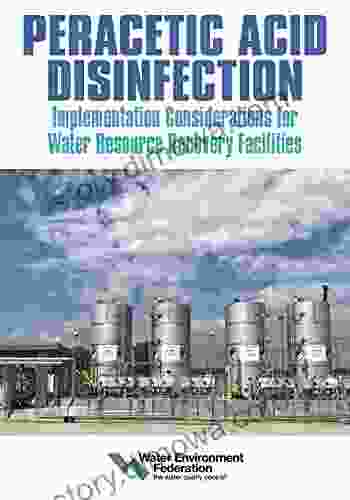Unlocking Sustainable Water Management: Implementation Considerations for Water Resource Recovery Facilities

In an era marked by dwindling water resources and environmental concerns, the implementation of effective water resource recovery facilities (WRRFs) has become paramount. These facilities offer a transformative approach to wastewater management, transforming wastewater into a valuable resource while safeguarding public health and the environment. However, the successful implementation of WRRFs requires careful consideration of a wide range of factors, from technical aspects to financial implications and regulatory compliance.
This comprehensive guide, "Implementation Considerations for Water Resource Recovery Facilities," delves into the intricate details of WRRF implementation. Written by industry experts, this book provides invaluable insights into the planning, design, operation, and maintenance of these critical facilities. Whether you're a water utility professional, engineer, or decision-maker seeking to enhance water resource management, this book will serve as an indispensable tool.
4.4 out of 5
| Language | : | English |
| File size | : | 6617 KB |
| Text-to-Speech | : | Enabled |
| Enhanced typesetting | : | Enabled |
| Lending | : | Enabled |
| Screen Reader | : | Supported |
| Print length | : | 506 pages |
Chapter 1: Planning and Design Considerations
The foundation of a successful WRRF lies in meticulous planning and design. This chapter explores the key steps involved in this process, including:
- Needs Assessment: Identifying the community's water resource challenges and determining the appropriate WRRF capacity and treatment processes.
- Site Selection: Evaluating potential sites based on factors such as land availability, environmental impact, and accessibility.
- Process Selection: Choosing the most effective treatment technologies based on influent characteristics, discharge requirements, and cost considerations.
- Design Criteria: Establishing design parameters for treatment units, piping systems, and ancillary facilities.
Chapter 2: Regulatory Compliance
WRRFs are subject to stringent regulatory requirements at both the federal and state levels. This chapter provides a comprehensive overview of these regulations, including:
- Clean Water Act: Discussing the National Pollutant Discharge Elimination System (NPDES) permit program and its implications for WRRF design and operation.
- State Regulations: Exploring state-specific regulations that may impose additional requirements beyond federal mandates.
- Compliance Strategies: Outlining best practices for ensuring regulatory compliance throughout the WRRF lifecycle.
Chapter 3: Financial Considerations
The implementation of WRRFs involves significant capital investment and ongoing operating costs. This chapter examines the financial aspects of WRRF projects, including:
- Cost Estimation: Estimating capital and operating costs associated with different treatment options and design scenarios.
- Financing Options: Exploring various financing mechanisms available for WRRF projects, including grants, loans, and public-private partnerships.
- Life-Cycle Cost Analysis: Performing a comprehensive analysis of the long-term financial implications of WRRF projects.
Chapter 4: Operation and Maintenance
The successful operation and maintenance of WRRFs is essential for ensuring optimal performance and regulatory compliance. This chapter covers the key aspects of O&M, including:
- Staffing and Training: Identifying the necessary staffing levels and providing training programs to ensure a skilled workforce.
- Process Monitoring: Establishing a comprehensive monitoring program to track performance and identify potential issues.
- Preventative Maintenance: Outlining proactive maintenance practices to prevent equipment failures and extend facility lifespan.
- Emergency Preparedness: Developing plans and procedures for handling emergencies and minimizing downtime.
Chapter 5: Resource Recovery and Beneficial Reuse
WRRFs can play a crucial role in resource recovery and beneficial reuse, transforming wastewater into valuable assets. This chapter explores the potential for:
- Bioenergy Production: Utilizing anaerobic digestion or other technologies to generate biogas for energy generation.
- Reclaimed Water: Treating wastewater to meet reuse standards for irrigation, industrial purposes, or groundwater recharge.
- Sludge Management: Managing sludge byproducts through land application, composting, or incineration.
- Nutrient Recovery: Recovering nutrients, such as nitrogen and phosphorus, from wastewater for use as fertilizer.
Chapter 6: Public Engagement and Stakeholder Involvement
Effective WRRF implementation requires active engagement with the public and key stakeholders. This chapter emphasizes the importance of:
- Community Outreach: Informing the community about the project, its benefits, and potential impacts.
- Stakeholder Involvement: Engaging with regulatory agencies, environmental groups, and other stakeholders to address concerns and build support.
- Public Education: Raising awareness about the role of WRRFs in protecting water resources and promoting sustainable practices.
The implementation of water resource recovery facilities is a complex undertaking that requires careful planning, design, regulatory compliance, financial considerations, and a focus on resource recovery and beneficial reuse. This guide, "Implementation Considerations for Water Resource Recovery Facilities," provides a comprehensive roadmap for successful WRRF implementation, empowering water utility professionals, engineers, and decision-makers to make informed decisions that safeguard public health, protect the environment, and ensure the sustainability of our water resources.
Free Download Your Copy Today
To Free Download your copy of "Implementation Considerations for Water Resource Recovery Facilities," visit our website at [insert website address]. This essential guide will serve as your invaluable resource for planning, designing, operating, and maintaining effective WRRFs that meet the challenges of the 21st century.
4.4 out of 5
| Language | : | English |
| File size | : | 6617 KB |
| Text-to-Speech | : | Enabled |
| Enhanced typesetting | : | Enabled |
| Lending | : | Enabled |
| Screen Reader | : | Supported |
| Print length | : | 506 pages |
Do you want to contribute by writing guest posts on this blog?
Please contact us and send us a resume of previous articles that you have written.
 Book
Book Novel
Novel Page
Page Chapter
Chapter Text
Text Story
Story Genre
Genre Reader
Reader Library
Library Paperback
Paperback E-book
E-book Magazine
Magazine Newspaper
Newspaper Paragraph
Paragraph Sentence
Sentence Bookmark
Bookmark Shelf
Shelf Glossary
Glossary Bibliography
Bibliography Foreword
Foreword Preface
Preface Synopsis
Synopsis Annotation
Annotation Footnote
Footnote Manuscript
Manuscript Scroll
Scroll Codex
Codex Tome
Tome Bestseller
Bestseller Classics
Classics Library card
Library card Narrative
Narrative Biography
Biography Autobiography
Autobiography Memoir
Memoir Reference
Reference Encyclopedia
Encyclopedia Lucas Mann
Lucas Mann Livi Michael
Livi Michael Muhammad Khan
Muhammad Khan Lisbeth Kaiser
Lisbeth Kaiser Lori Soard
Lori Soard Maddy Bell
Maddy Bell Marc Marquez
Marc Marquez Louise Chipley Slavicek
Louise Chipley Slavicek Ned Tarrington
Ned Tarrington Suanna H Davis
Suanna H Davis Stanley Katz
Stanley Katz Robert Sulley
Robert Sulley Lensey Namioka
Lensey Namioka Marco Santagata
Marco Santagata Thomas Lockwood
Thomas Lockwood Mal Peet
Mal Peet Arnold Bennett
Arnold Bennett Lydia Sharp
Lydia Sharp Truman Capote
Truman Capote Lee Strauss
Lee Strauss
Light bulbAdvertise smarter! Our strategic ad space ensures maximum exposure. Reserve your spot today!

 Henry David ThoreauPlan Your Magical Walt Disney World Adventure with the Ultimate Daily and...
Henry David ThoreauPlan Your Magical Walt Disney World Adventure with the Ultimate Daily and... Patrick RothfussFollow ·10.5k
Patrick RothfussFollow ·10.5k Charles DickensFollow ·13.2k
Charles DickensFollow ·13.2k Andres CarterFollow ·14k
Andres CarterFollow ·14k Giovanni MitchellFollow ·8.2k
Giovanni MitchellFollow ·8.2k Dion ReedFollow ·12.8k
Dion ReedFollow ·12.8k Terry PratchettFollow ·11.7k
Terry PratchettFollow ·11.7k Henry HayesFollow ·4.8k
Henry HayesFollow ·4.8k Zachary CoxFollow ·6.8k
Zachary CoxFollow ·6.8k

 Charles Bukowski
Charles BukowskiDemystifying AI's Challenges and Embracing its Promise: A...
In the rapidly...

 Roald Dahl
Roald DahlHow America's Most Popular Sport Is Just Getting Started:...
Baseball, the quintessential...

 Francis Turner
Francis TurnerShareholder Empowerment: A New Era in Corporate...
The role of...

 Wesley Reed
Wesley ReedBig Points About The Pack Line Defense: The Ultimate...
The Pack Line Defense is a...
4.4 out of 5
| Language | : | English |
| File size | : | 6617 KB |
| Text-to-Speech | : | Enabled |
| Enhanced typesetting | : | Enabled |
| Lending | : | Enabled |
| Screen Reader | : | Supported |
| Print length | : | 506 pages |














